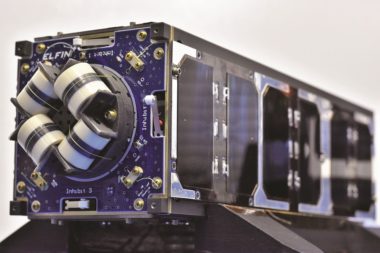Pupils working the twin Electron Losses and Fields Investigation (ELFIN) cubesats were going into finals at the University of California, Los Angeles, when they recognized they had to immediately transition into remote operations.
“When all of us were completed taking three-hour tests, we’d three-hour meetings to determine what we wanted the tanks to do and how to make it as simple as possible from a technical and software standpoint,” said Sharvani Jha, ELFIN software development guide.
Even the COVID-19 pandemic has motivated operators throughout the nation to abandon mission operations centers in favor of kitchen tables and living rooms. The trend today extends into NASA-funded assignments like ELFIN and two mathematics satellites operated by the Utah State University Space Dynamics Laboratory (SDL): Hyper-Angular Rainbow Polarimeter and Compact Infrared Radiometer in Space.
Both UCLA and SDL worked to set up remote operations.
“We watched it as being quite helpful to have added flexibility whether somebody was on traveling, encouraging another program or encouraging calls on weekends or during graveyard shifts,” said Tim Neilsen, SDL Commercial and Civil Space Division application manager.
Before the pandemic, SDL had secure communications links between its Logan, Utah, headquarters and ground stations in the NASA Wallops Flight Facility in Virginia to support assignments like Hyper-Angular Rainbow Polarimeterand also a three-unit SDL cubesat using a tool from the University of Maryland, Baltimore County, to detect aerosol and cloud properties, and Compact Infrared Radiometer in Space, a six-unit cubesat constructed by Ball Aerospace to accumulate Earth imagery for scientific research.
UCLA students started establishing entry for operation of their NASA-funded ELFIN cubesats soon when they launched in 2018. Charge: UCLA”What is new and what did require some serious thought and design function was the last leg from our headquarters into our unique houses using proper technology and virtual private networking technologies,” Neilsen said. Seven SDL satellite operators and the mission operations centre central servers and computers in Logan can connect from their house workstations, and from there to Wallops, he included.
UCLA students started establishing access soon after ELFIN started in 2018 along with NASA’s Ice, Cloud and land Elevation Satellite-2.
“We have winter break and summer break at which we wouldn’t be in Los Angeles physically,” said Rebecca Yap, ELFIN mission operations manager. “Being able to set up a flexible surgeries workflow was important.”
Throughout the school holidays at least one ELFIN satellite operator remained on campus with access to the mission operations centre and satellite communications antenna .
That is no longer possible since instruction moved online in March.
A cubesat that finds energetic electrons travel in the Van Allen radiation belts toward Earth , ELFIN, is continued to carry out its science mission. Surgeries , though, are making it difficult to train satellite operators.
“We can not hold in-person coaching sessions for recruits,” Yap said. “And we are not physically within the mission operations center to help them.”
Moreover, ELFIN operators overlook working in the mission operations centre.
“You make a lot more mistakes whenever you are working remotely without somebody looking over your knee or another operator to riff off of,” Yap said.
To prevent errors, the ELFIN staff is software that is rewriting and operations. Currently, spacecraft data collection tasks are planned by the most experienced operators of ELFIN while recruits decide whether the satellites performed as anticipated. Otherwise, recruits hammer controls directing the satellite to assemble the information.
SDL satellite operators in Utah also see a few of the drawbacks of working at home.
“However, there are always communication challenges once the mission operations staff is dispersed in numerous places during an overpass, while planning to get an overpass or assessing data after an overpass. We want older and well-designed tools to make up for the simple fact that we are not in a conference room working together onto a whiteboard.”
Moreover, SDL satellite operators are sometimes frustrated by slow internet connections.
“A number of us are seeing speed affects from the number of people working from your home and kids going to college remotely,” Neilsen said. “We’ve seen some minimal consequences in that class, but fortunately they’ve been quite minimal.”
Overall, SDL remote operations have”slight impacts” on satellite surgeries,” Neilsen said. “We are getting the work done and the expense to the clients has not increased on both of these assignments because of COVID-19.”
Meanwhile, UCLA’s ELFIN operators have been nearly finished writing new software to make it easier to command the satellites remotely.
– Advertisement –
